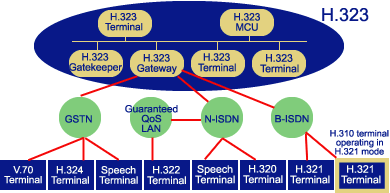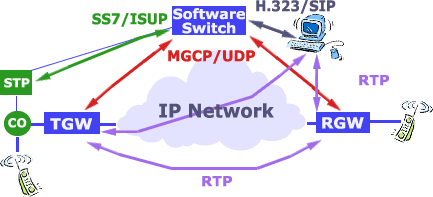An IP telephony network that provides carrier-grade telephony service to a growing
customer base needs a distributed architecture that separates call processing functions
from actual media streaming devices. This architecture can give carriers greater control
over network operations and deployment of new services.
On the network side, carriers need full control of network management and call routing
functions. On the customer premises equipment (CPE) side, carriers need cost-effective
client systems that are interoperable and reliable, as well as scalable. The CPE needs to
be well defined in order to support the easy deployment of new services without massive
upgrades. The peer-to-peer architecture of existing IP telephony protocols, such as Simple
Internet Protocol (SIP) and H.323, does not match these needs.
The Media Gateway Control Protocol (MGCP) is being used to extend the first generation
of IP telephony networks into the merged voice and data networks of tomorrow by clearly
separating switching and application equipment from CPE equipment, and providing a
well-defined interface between the two.
The two major protocols discussed here, H.323 and MGCP, are different methods of
describing how an IP telephony network should operate in processing calls for the
network's IP side, as well as describing network architecture and how it is deployed.
H.323 Architecture And Interoperability
The H.323 standard includes technology for both point-to-point and multipoint conferences,
as well as for embedded PCs and standalone devices. It addresses call control, multimedia
management, bandwidth management, and interfaces between LANs and other networks.
In H.323, a minimum of two gateways and one gatekeeper are required in order to set up
a call between two circuit-switched zones. The gatekeeper is responsible for address
resolution, or determining where the call is terminated, as well as address translation
and bandwidth management. An H.323 gateway device is primarily responsible for media
streaming and call processing. Thus, the H.323 architecture is relatively concentrated
(see below).

When the H.323 specification was originally approved by the ITU in 1996, it had been
written as an adaptation of H.320, which was created for videoconferencing over ISDN and
other circuit-switched networks. Since H.323 v2 was approved in 1998, it has also been
used for communication over IP networks. With the growth of IP telephony networks, H.323
v2 has been further adapted for this use.
However, H.323 v2 was not specific enough about defining mandatory gateway
capabilities, or ensuring that various implementations would be interoperable, especially
when optional capabilities were added. Consequently, implementers produced equipment that
did not interoperate with other vendors' systems.
Recently, the iNOW! Activity Group of
the International Multimedia Teleconferencing Consortium (IMTC) has worked to define a
single profile for H.323, and to certify vendors to that profile. The profile's third
version is now available. It defines the minimum and optional levels of capabilities that
every gateway must possess. Gateway, gatekeeper, terminal and provisioning system vendors
are beginning to hold "dongle-fests" to informally test their equipment's
interoperability, and some third-party laboratories have begun certification tests as
well.
MGCP Architecture And Local Access Equipment
Because of its concentrated, peer-to-peer architecture, with multiple platforms running
multiple software programs, H.323 makes it difficult for carriers to control where and
when new applications are deployed on the network. H.323 hardware and software do not
easily lend themselves to scaling. In addition, the complexity and intelligence of H.323
gateways make them costly to build, and therefore less reliable than systems based on a
simpler design.
The Media Gateway Control Protocol (MGCP) is a combination of the Bellcore Simple
Gateway Control Protocol (SGCP) and the IP Device Control protocol from Level 3 Communications. SGCP arose from the need to
separate the software-centric call processing functions from the hardware-centric media
streaming functions. These two functions were distributed between a call agent, or
software switch (softswitch), which handles call processing, and a media gateway, which
performs IP voice streaming. But communication between these two now-separate entities
could not be handled by the peer-to-peer H.323 or SIP protocols. Since a master/slave
protocol was needed, MGCP was created.
The developers of MGCP emphasized simplicity and reliability. By offloading
call-processing decisions to the softswitch, media gateways have become simple devices.
Examples of media gateways include small office voice-over-DSL gateways, cable modems, and
set-top boxes. The MGCP protocol itself was kept simple by limiting its role to media
streaming control. The overall design allows for reliable, scalable and low-cost
implementations (see below).

Call agent software may be distributed over more than one computer platform, such as
relatively inexpensive workstations. MGCP allows these programs to externally control and
manage media gateways at the edge of multi-service packet networks. It also assumes that
these call agents will send synchronized commands to the gateways under their control,
although the protocol does not define a mechanism for that synchronization. The media
gateways are expected to simply execute those commands, without making any decisions.
Thus, media gateway functionality is fairly well defined by the MGCP standard, but only
the parts of a call agent implementation which are mandated for the protocol's operation
must be specified, such as timer management. The rest of the call agent's functionality is
left to developers and vendors.
The protocol assumes a connection model in which the basic elements are endpoints and
connections. Endpoints can be virtual or physical. Softswitches (call agents) instruct the
gateways to create connections between endpoints in order to detect events, such as an
off-hook condition, and to generate signals, such as ringing. They also specify how and
when connections are made between endpoints.
MGCP's separation of media streaming functions and call control functions creates a
division between the horsepower of the simple, dumb endpoints -- the media gateways -- and
the intelligence of the softswitches. This enhances overall system operation and greatly
simplifies the media gateway implementation. By shifting call intelligence to the
softswitches, local access equipment can be easily designed and made more reliable and
scalable, as well as less expensive. It needs only to bear the cost of the necessary
access hardware and the MGCP client-side functionality, while the cost of network
management and interoperability moves out into the network.
H.323 And MGCP: Cooperation, Not Competition
The MGCP and H.323 protocols complement, rather than compete with, each other. The
distributed MGCP system functions at the edge of multi-service packet networks. At the
core of the network, between the softswitches, SIP or H.323 can be used as
inter-softswitch communication protocols.
For example, a softswitch can use MGCP on the local connection to its subordinate media
gateways, while still using H.323 or SIP to synchronize with other softswitches. In a
typical configuration, a softswitch interfaces on one side with one or more telephony
switches, and on the other side with H.323-compliant systems.
Calls can pass quickly and easily to an H.323 terminal or gateway from an
MGCP-controlled media gateway through the softswitch, because softswitches may already
implement the H.323 signaling layers for communication among themselves. In effect, the
softswitch/media gateway combination forms a distributed H.323 system, in which the H.323
gateway has been broken down into these two entities. Consequently, the softswitch
presents itself to H.323 systems as an H.323-compliant system.
Future Directions In MGCP
A unified architecture and specification for next-generation, convergent networks will
enable a smooth adoption rate and vendor interoperability. This is true for all broadband
access technologies that can provide last mile access for business and residential
customers, such as cable, xDSL or wireless. MGCP is being developed to enable a
commonality among voice-over-packet solutions that is independent of the access
technology. The industry is coming together behind initiatives such as PacketCable and the SoftSwitch Consortium to promote a single standard
that will enable rapid deployment.
Shmuel Bachinsky is the senior director of business development for AudioCodes, Inc., a leading vendor of
voice-over-packet solutions and the key originator of the ITU G.723.1 standard for the
emerging IP telephony market. For more information on AudioCodes and its enabling
technologies and products for voice-over-packet networks, call 408-577-0488, e-mail
[email protected], or visit the company's Web site at www.audiocodes.com. |